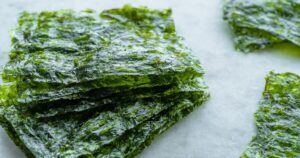Originating from Japan, sashimi is a dish about simplicity and reverence for quality ingredients. It’s a showcase of skill, where the freshness of the seafood takes center stage, and the chef’s knife work is on full display.
Imagine a slice of seafood at its freshest, its flavor as pure and unadulterated as the ocean it came from. Each type of sashimi has its own distinct taste, from the light and delicate flavors of white fish like flounder to the rich, buttery taste of toro, the prized belly portion of the tuna.
But sashimi isn’t just about taste. It’s also about texture. The feel of it in your mouth can be just as important as the flavor. Some sashimi can be silky and melt-in-your-mouth, while others offer a satisfying firmness.
Let’s dive into the world of sashimi and discover what makes it such a beloved dish in and outside of Japan.
What Is Sashimi?
Sashimi is a traditional Japanese dish that’s all about simplicity and an appreciation for quality ingredients. It consists of fresh, raw fish or seafood expertly sliced into thin, delicate pieces.
Visually, sashimi is a feast for the eyes. The slices of fish are often arranged artfully on a platter, their vibrant colors and glossy sheen a testament to their freshness. It’s typically served with a side of soy sauce for dipping, a dab of wasabi for heat, and slices of pickled ginger to cleanse the palate between bites.
What Does Sashimi Taste Like?
Ah, the taste of sashimi. It’s a question that’s not so easily answered, as the flavor can vary greatly depending on the type of fish or seafood used. But let me try to paint a picture for you.

Imagine taking a bite of tuna sashimi. It’s rich, almost creamy, with a subtly sweet taste and a hint of the sea. Now, contrast that with a slice of salmon sashimi, which is lighter, with a buttery texture and a delicate, slightly sweet flavor. Then there’s yellowtail sashimi, which has a firm texture and a rich, almost smoky flavor.
Each type of sashimi offers a unique taste experience, a testament to the diversity of the ocean’s bounty.
But sashimi isn’t just about the seafood itself. It’s also about the accompaniments that enhance its flavor.

A dab of wasabi adds a fiery kick that cuts through the richness of the fish, while a light dip in soy sauce brings out its umami qualities.
And let’s not forget the thin slices of pickled ginger served on the side, their tangy freshness a perfect palate cleanser between bites.
As for the smell, fresh sashimi should have a clean, ocean-like scent. It shouldn’t smell fishy at all. In fact, a strong fishy smell is a sign that the seafood isn’t fresh. Remember, when it comes to sashimi, freshness is key.
So, does sashimi taste good? As a home cook who loves exploring different flavors and has lived in Japan, I’d say it’s a resounding yes. But like any food, it’s all a matter of personal preference. If you’re a fan of seafood and enjoy fresh and clean flavors, then sashimi might just be a taste sensation you’ll love.
Types Of Sashimi
Sashimi comes in various forms, each offering a unique taste and texture. Here are a few of the most popular types:
- Tuna (Maguro): This is a classic choice for sashimi. It has a rich, almost steak-like flavor that’s subtly sweet. The prized belly portion, known as toro, is, particularly buttery and melt-in-your-mouth.
- Salmon (Sake): Known for its vibrant orange color, salmon sashimi has a light, delicate flavor, and a beautifully buttery texture.
- Yellowtail (Hamachi): This type of sashimi is known for its firm texture and rich, smoky flavor. It’s a favorite among many sashimi lovers.
- Scallop (Hotate): Scallop sashimi is sweet and tender, with a melt-in-your-mouth texture that’s truly unique.
- Octopus (Tako): Unlike the others, octopus sashimi has a chewy texture. It has a clean, slightly sweet flavor that’s enhanced by its firm bite.
What Does Sashimi Compare With?
If you’re trying to imagine what sashimi is like, it might be helpful to compare it with other foods:
- Ceviche: Like sashimi, ceviche features raw seafood. However, in ceviche, the seafood is “cooked” in citrus juices, giving it a tangy flavor you won’t find in sashimi.
- Crudo: This is the Italian version of sashimi. It’s typically dressed with olive oil and lemon juice, giving it a different flavor profile from the soy and wasabi, typically paired with sashimi.
- Carpaccio: Originally a dish of thinly sliced raw beef, carpaccio can also refer to thinly sliced raw fish. However, fish carpaccio is often marinated and served with a sauce, unlike sashimi.
- Poke: This Hawaiian dish features chunks of raw fish, often tuna, marinated in soy sauce and sesame oil. While it shares the raw fish element with sashimi, poke is more of a salad, with additions like seaweed, cucumber, and avocado.
- Smoked Salmon: While not raw, smoked salmon has a soft buttery texture similar to salmon sashimi. However, the smoking process gives it a distinctively smoky flavor that’s very different from sashimi’s clean, subtle taste.
How To Eat Sashimi
Eating sashimi is an experience that’s as much about the ritual as the taste. Here’s how you can fully enjoy this delicacy:
- Use Chopsticks: Sashimi is traditionally eaten with chopsticks. It’s part of the experience, allowing you to pick up each delicate slice with precision.
- Dip Lightly in Soy Sauce: Soy sauce is typically served with sashimi, but remember, it’s meant to enhance the flavor of the fish, not overpower it. Dip your sashimi lightly in the soy sauce, just enough to get a hint of its salty, umami flavor.
- Add a Touch of Wasabi: Wasabi is a spicy Japanese horseradish that adds a kick to your sashimi. But again, moderation is key. You want just enough to feel the heat without overwhelming the fish’s taste.
- Cleanse Your Palate with Ginger: Slices of pickled ginger, known as gari, are served with sashimi. Eat a piece between different types of sashimi to cleanse your palate to fully appreciate the unique flavor of each one.
- Savor Each Bite: Sashimi is not a dish to be rushed. Take the time to savor each bite, appreciating the freshness of the fish and the skill that went into preparing it.
Sashimi FAQs
What does sashimi taste like?
Sashimi has a fresh and clean taste that allows the natural flavors of the fish or seafood to shine through. The taste depends on the type of fish used, ranging from the rich, buttery flavor of tuna belly to salmon’s light, delicate flavor.
Is sashimi always raw?
Yes, traditional sashimi is always raw. It’s made from fresh, raw fish or seafood expertly sliced into thin pieces. The ingredients’ freshness is key to sashimi’s taste and texture.
What is the difference between sushi and sashimi?
While both sushi and sashimi involve raw fish, the main difference is in the presence of rice. Sushi refers to dishes that use vinegared rice, which can be served with various toppings, including raw fish. Sashimi, on the other hand, is simply raw fish served without rice.
How is sashimi prepared?
Sashimi is prepared by slicing fresh, raw fish or seafood into thin, delicate pieces. The process requires a sharp knife and a skilled hand to ensure the slices are clean and even. The sashimi is then typically served with soy sauce, wasabi, and pickled ginger.
What types of fish are used in sashimi?
Various fish and seafood can be used in sashimi, including tuna, salmon, yellowtail, scallop, and octopus. The key requirement is that the fish or seafood must be fresh and of high quality, as this impacts the taste, texture, and safety of eating the sashimi.
My Tasty Thoughts
As a home cook, I’ve always found joy in the simplicity of sashimi. It’s a dish that truly respects its ingredients, allowing the fish’s natural flavors to take center stage.
Each slice of sashimi is a testament to the chef’s skill and the seafood’s freshness, and there’s something incredibly satisfying about that. So, should you try sashimi? Absolutely! Whether you’re a seafood lover or just someone who appreciates good food, sashimi is a dish worth experiencing.


